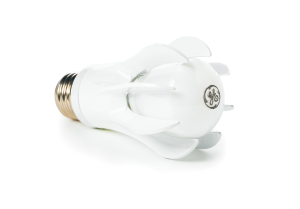May 13 2010
As soon as consumers see GE’s new Energy Smart® 9-watt LED bulb on retail store shelves later this year, they’ll know it’s different from the "snow cone" designs of other LED incandescent replacement bulbs.
The GE bulb’s unique fin-like design allows it to operate differently, distributing light like a traditional 40-watt incandescent bulb while delivering excellent light output over its 25,000-hour rated life.
 The GE bulb's unique fin-like design allows it to operate differently, distributing light like a traditional 40-watt incandescent bulb while delivering excellent light output over its 25,000-hour rated life.
The GE bulb's unique fin-like design allows it to operate differently, distributing light like a traditional 40-watt incandescent bulb while delivering excellent light output over its 25,000-hour rated life.
GE’s new LED bulb—which will last 17 years based on its rated life and four hours use per day—is expected to receive ENERGY STAR® certification as an omni-directional LED replacement lamp. That means it emits light all around the bulb. The certification requires excellent efficiency, light output, color and life, as well as uniform distribution of light in all directions surrounding the bulb, except in a narrow range of angles near the base of the bulb.
“Our new LED bulb is an engineering marvel that will deliver incandescent-quality light for years upon years in any room of a home,” says Steve Briggs, vice president of marketing and product management, GE Lighting. “Your kids can literally grow up while this light serves its purpose in their bedroom desk lamp—from kindergarten through 12th grade.”
What’s up with the fins?
The fins that cradle the GE Energy Smart LED bulb look ultra cool while performing a cooling function: they’re connected to the LEDs inside the bulb to draw heat out, keeping the LEDs cool to ensure a longer life and greater efficiency. The fins also keep the surface of the bulb cooler than comparable incandescent bulbs.
“The typical design of most LED A-line bulbs on the market has a thermal-management component mounted only on the bottom half of the light bulb, while the top half is similar to a snow cone shape,” says Briggs. “We designed and tested several variations of the snow cone approach, but none provided the incandescent-like all around light that ENERGY STAR requires without overheating the LEDs. Our fins envelop the glass bulb in a way that preserves a uniform distribution of light while keeping the LEDs cool.”
GE Lighting Physicist and Principal Engineer Gary Allen invented the new GE LED bulb and perfected its design with the help of a globally dispersed innovation team.
“We wanted our new LED bulb to provide a light distribution, light quality and aesthetic appearance as close as possible to our popular GE Soft White incandescent light bulb,” says Allen. “The idea was to deliver what customers love—soft white light—in an LED bulb that deals with the directionality challenge that’s typical with LEDs.”
Performance
GE’s new LED bulb produces 450 lumens (the LED Energy Star® threshold to be considered a 40-watt incandescent replacement effective August 31, 2010), provides 77 percent energy savings and lasts more than 25 times as long as a standard incandescent bulb. The LED bulb also better directs light downward and all around, performing similarly to the incandescent bulbs that consumers have known and used forever. “Snow cone” LED bulbs tend to project light just out the top of a lampshade, because LEDs are inherently directional light sources.
By harnessing GE’s industry-leading LED technology and consumer feedback, the new LED bulb delivers both form and function that looks better aesthetically, enhances heat removal more efficiently and distributes light uniformly in all directions. For additional details and estimated pricing on the new LED bulb, click here.
Quality
GE is addressing the issues of LED quality and reliability by pushing for a universal set of LED performance standards. Much of its work with NEMA, the Department of Energy/ENERGY STAR, ANSI, Intertek and IESNA centers on the development of measurement, efficiency and performance guidelines that clarify LED standards. A proven expert in the LED category, GE has sold more than 25 million linear feet of LED lighting.